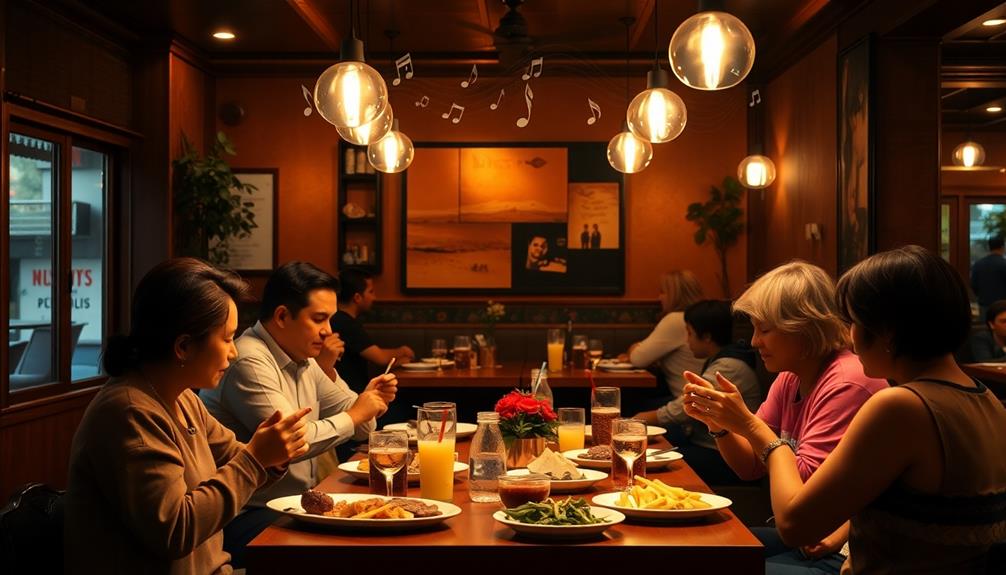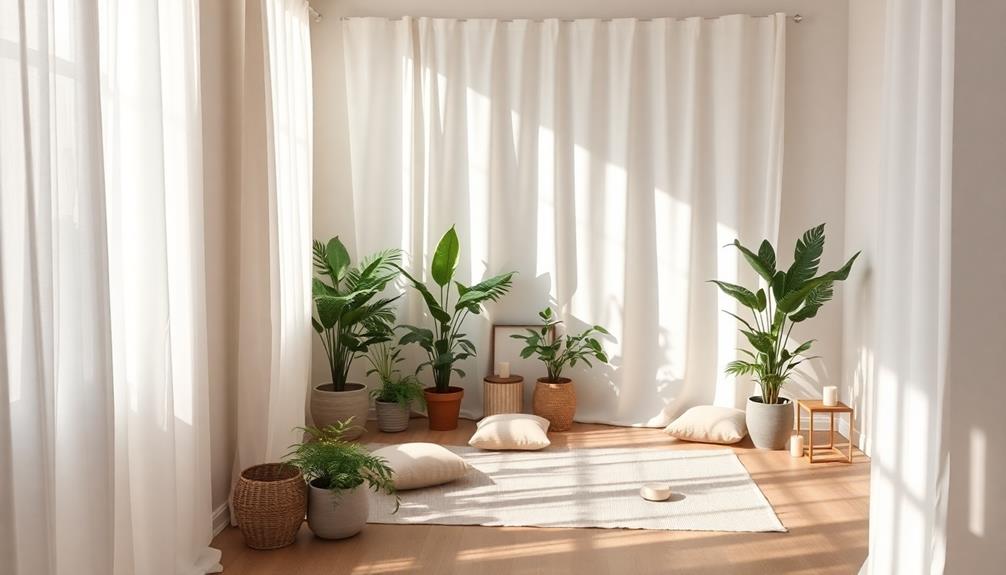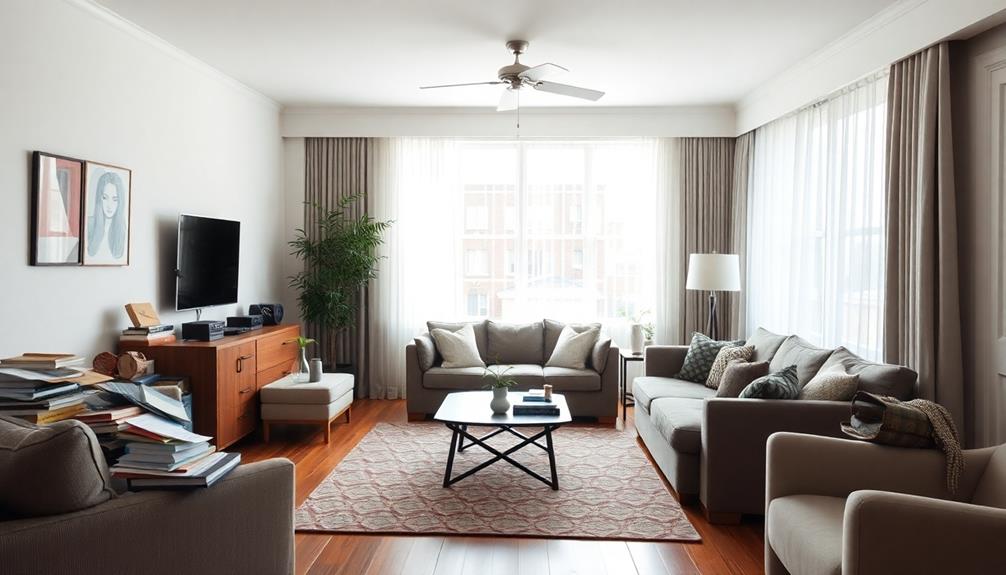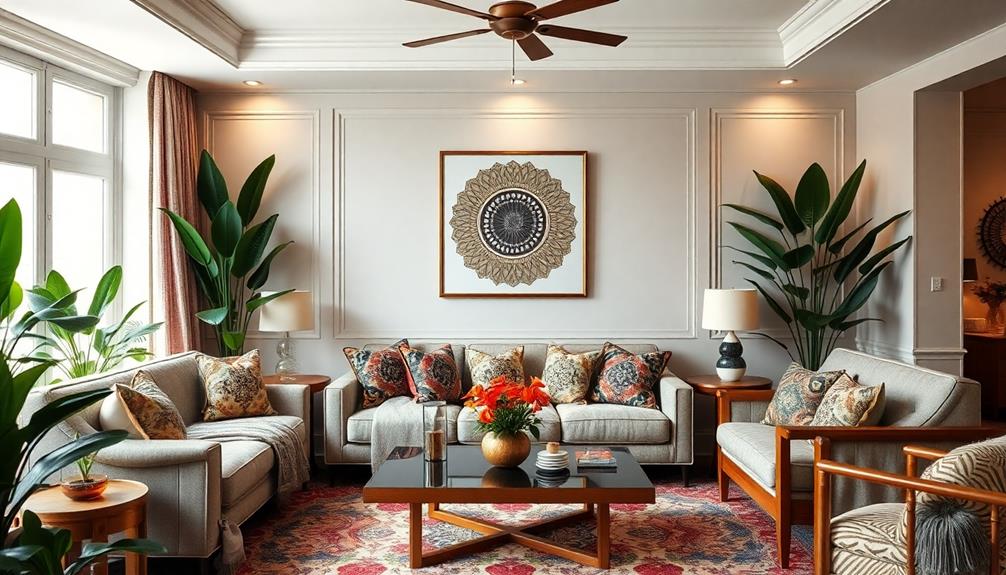Batik fabric can completely transform your living room, bringing in vibrant colors and rich cultural stories. With its intricate patterns, batik acts as a stunning focal point, whether you use it for throw pillows, curtains, or wall art. Each piece carries unique meanings and reflects Indonesia's heritage, creating a sense of connection in your space. Plus, it harmonizes beautifully with neutral palettes, enhancing your decor without overwhelming it. You'll find that integrating batik into your home not only elevates your aesthetics but also adds a personal touch. Stick around to uncover more ways to incorporate this stunning fabric!
Key Takeaways
- Batik fabric offers vibrant patterns and deep cultural significance, adding unique character to your living room decor.
- Incorporating batik throw pillows or table runners introduces bold colors and textures, enhancing the overall aesthetic.
- The versatility of batik allows it to complement both traditional and modern design elements seamlessly.
- Using batik as wall hangings creates focal points that showcase Indonesian textile art and heritage.
- Selecting specific batik patterns can convey personal style while celebrating cultural narratives, enriching your living space.
The Allure of Batik Fabric

While you might be drawn to various fabric choices for your living room, batik fabric stands out with its rich history and stunning designs. This traditional Indonesian textile showcases intricate batik patterns created through a unique wax-resist dyeing technique. Each design tells a story, often reflecting cultural narratives that can add depth to your interior spaces.
Incorporating a unique artistic expression from Indonesian culture, batik fabric not only captivates the eye but also evokes appreciation for traditional craftsmanship.
Imagine draping a Batik Parang Kusumo throw over your sofa. This specific pattern symbolizes life's struggles and prosperity, making it not just beautiful but meaningful. With a diverse range of materials like silk and cotton, batik fabrics offer a variety of textures and colors, allowing you to tailor your living room decor to your personal style.
Modern adaptations of batik have emerged, merging traditional designs with contemporary aesthetics, appealing to a wider audience. Incorporating batik-inspired textiles as accent pieces can completely transform your living room's ambiance, creating a warm and inviting atmosphere.
Not only do these fabrics enhance your interior design, but they also support the preservation of traditional craftsmanship, making your decor choice a thoughtful one. Embrace the allure of batik and elevate your living space with its timeless beauty.
Historical Roots of Batik

Batik's enchanting beauty is rooted in a rich history that spans over a millennium. This traditional Indonesian textile art traces its origins back over 1,000 years, possibly connecting to ancient Egypt or Sumeria. The earliest known practices of batik emerged in Ponorogo, East Java, before the 7th century, during the Mataram Sultanate.
It was here that distinct batik motifs developed, each carrying cultural and philosophical meanings. These motifs not only serve as artistic expressions but also signify social status and identity within Indonesian society. Historically, certain patterns were reserved for royalty, showcasing the significance of craftsmanship in relation to hierarchy.
Additionally, the vibrant artistry of batik resonates with the same cultural richness found in Indonesian decor masks, which also tell stories of local traditions and heritage traditional artistry. UNESCO's recognition of batik as a Masterpiece of the Oral and Intangible Heritage of Humanity emphasizes its importance in cultural heritage and community storytelling.
As you explore the world of Indonesian Batik, you'll appreciate the evolution of its techniques, such as Batik Tulis (hand-drawn) and Batik Cap (stamped). These methods reflect the historical craftsmanship and innovation that have shaped batik's enduring legacy.
Unique Techniques and Styles

The artistry of Indonesian batik captivates with its unique techniques and styles, each showcasing the skilled craftsmanship behind this vibrant textile. One of the most revered methods is Batik Tulis, where artisans hand-draw intricate designs using hot wax, creating detailed and personal batik patterns.
In contrast, Batik Cap employs copper stamps for a quicker production process while still maintaining high quality. Both methods highlight the dedication and artistry of the craftspeople. Additionally, these stunning fabrics can be beautifully integrated into your home decor, such as with Indonesian decorative pillows, adding a touch of comfort and cultural heritage to your living space.
The wax-resist dyeing technique allows for rich colors and complex designs, as each piece often undergoes multiple dyeing and waxing cycles. Regional styles add further depth; for example, Pekalongan batik features lively motifs, while Batik Mega Mendung from Cirebon showcases stunning cloud patterns.
Batik Parang Kusumo, symbolizing life's struggles, originates from Solo and reflects local history and culture. Another striking style is Batik Tambal from Yogyakarta, known for its patchwork designs and bold colors.
These unique techniques and styles not only create beautiful batik fabric but also offer a way to infuse your living space with character and cultural richness, making each piece a conversation starter in your home.
Incorporating Batik in Home Decor

Incorporating batik into your home decor starts with selecting unique patterns that resonate with your style.
The intricate designs of batik can enhance the aesthetic appeal of your space, much like the importance of Indonesian decor masks which represent rich cultural heritage and traditions.
You can coordinate colors from the batik fabric with your existing palette to create a cohesive look.
Unique Pattern Selection
While searching for ways to elevate your living room decor, consider the unique patterns of batik fabrics that can instantly draw attention and spark conversation. These intricate designs, deeply rooted in Indonesian art, serve as stunning focal points. From vibrant throws to cushions, batik textiles can enhance your living space's overall aesthetic.
Batik offers various regional variants, each with distinct motifs and meanings. This allows you to choose patterns that resonate with your personal style while appreciating traditional Batik's rich cultural significance. Here's a quick look at some popular batik patterns:
| Batik Pattern | Description |
|---|---|
| Batik Mega Mendung | Features cloud motifs, symbolizing hope and prosperity. |
| Batik Parang Kusumo | Represents the balance of life's dualities with its flowing lines. |
| Batik Tujuh Rupa | Emphasizes the beauty of nature with floral designs. |
| Batik Cirebon | Combines various elements, showcasing eclectic aesthetics. |
Incorporating these patterned textiles can bridge traditional and modern styles, making them versatile for any decor scheme. By selecting batik patterns that complement your existing elements, you create a cohesive and inviting atmosphere in your living room.
Color Palette Coordination
When you're adding batik to your home decor, paying attention to the color palette is essential. Batik often features vibrant, intricate patterns that can become a stunning focal point in your living room.
To create a cohesive look, consider using batik fabrics like Batik Tulis and Batik Cap for accent pieces such as cushions and throws. These rich cultural textiles can harmonize beautifully with neutral or solid color schemes, enhancing the overall aesthetic.
Additionally, incorporating elements from luxury tropical design aesthetics can enrich your decor, blending natural textures with batik's vibrant colors.
Mixing batik with complementary colors or textures helps maintain a balanced feel, allowing the unique patterns to shine without overwhelming the space. You might even use batik as a statement piece, like a feature wall or art panel, to contrast against minimalist furniture styles. This approach elevates your decor while celebrating the artistry of batik.
If you prefer a subtler integration, incorporating batik in small doses, such as table runners or framed fabric art, can add elegance without dominating your decor.
Ultimately, a thoughtful color palette coordination will guarantee that your batik pieces enhance your living room's charm and character.
Versatile Fabric Applications
Batik fabrics frequently find their way into various home decor applications, bringing vibrant patterns and cultural significance to your living room.
This versatile fabric can seamlessly blend with the elements of Balinese design characteristics, enhancing the overall aesthetic while showcasing this beautiful art form. By incorporating batik into your space, you can elevate the overall aesthetic while showcasing this beautiful art form.
Here are some versatile ways to use batik fabric:
- Throw pillows: Add pops of color and texture that invite comfort.
- Curtains: Make a bold statement while filtering light beautifully.
- Table runners: Create a stunning centerpiece that draws attention during gatherings.
- Wall hangings: Transform blank walls into a gallery of Indonesian textile art.
- Upholstery: Reupholster chairs or sofas to reflect unique craftsmanship and style.
Using batik in your home decor allows you to mix vibrant designs with solid color furnishings, creating a balanced look.
The intricate patterns can serve as stunning accent pieces, enhancing modern bohemian interiors while avoiding visual overwhelm.
Cultural Significance of Batik

When you explore batik, you'll discover that each pattern carries deep symbolism, often tied to social status and historical narratives.
This traditional Indonesian fabric, much like the distinct architectural styles of Rumah Adat, showcases the diverse cultural influences across the regions of Indonesia.
It's fascinating to see how batik plays a role in various ceremonies, with specific colors and designs conveying important messages.
Through its intricate craftsmanship, batik not only represents Indonesia's rich heritage but also fosters a strong sense of identity within communities.
Symbolism in Batik Patterns
Have you ever wondered about the stories woven into the intricate patterns of batik? This art form isn't just visually stunning; it's steeped in rich symbolism that speaks volumes. The use of traditional Indonesian style home decor often incorporates batik, enhancing the aesthetic appeal of your living space while celebrating cultural heritage.
- Each pattern tells a unique story.
- Specific motifs convey social class distinctions.
- Natural elements highlight the connection to the environment.
- Historical narratives are embedded in the designs.
- Batik is recognized globally for its cultural significance.
In Central Java, for instance, the Parang design is traditionally linked to royalty, symbolizing power and authority. Meanwhile, the Batik Mega Mendung features cloud motifs that represent emotional control, deeply rooted in local philosophy.
The Batik Tujuh Rupa showcases animal and plant motifs, reflecting ancestral culture and the importance of nature in Indonesian traditions.
These symbolism in batik patterns elevate the fabric from mere decoration to a profound expression of identity and heritage.
UNESCO's recognition of batik as a Masterpiece of the Oral and Intangible Heritage of Humanity underlines its importance in conveying the beliefs and values of communities.
Batik in Ceremonial Contexts
In Indonesian culture, batik plays an essential role in various ceremonies, especially during weddings and religious events. Each batik pattern you encounter isn't just decorative; it carries significant meanings tied to social status and virtues. For instance, certain colors and designs are reserved for nobility, reflecting a deep cultural hierarchy.
When you wear batik at these events, you're not merely dressed in fabric; you're participating in a rich tradition that tells stories of nature, history, and identity. Incorporating batik patterns into event decor, such as traditional wedding decor ideas, can enhance the cultural atmosphere and celebrate this remarkable art form.
During ceremonies, batik garments often serve as cherished family heirlooms, passed down through generations. This practice underscores their cultural significance, as they connect past and present.
You'll notice that distinct regional motifs not only enhance the beauty of the attire but also embody local beliefs and traditions, reinforcing community values.
Batik's recognition by UNESCO as a Masterpiece of the Oral and Intangible Heritage of Humanity emphasizes its importance in preserving these cultural practices.
Heritage and Identity Representation
Embracing the beauty of batik means connecting with a rich tapestry of heritage and identity that defines Indonesian culture. This intricate fabric isn't just a textile; it's a vibrant symbol of social status and community values.
Each batik design you encounter carries deep cultural meanings, often depicting nature, virtues, and historical narratives. Moreover, batik's relevance extends beyond clothing, as its patterns and colors can be seen in traditional Indonesian housing, highlighting its role in traditional architecture.
- Batik patterns historically indicate social status, with exclusive designs for royalty.
- UNESCO recognizes batik as a Masterpiece of the Oral and Intangible Heritage of Humanity.
- Traditional batik is integral to rituals and ceremonies, preserving cultural practices.
- Regional variants, like Batik Parang Kusumo and Batik Mega Mendung, showcase Indonesia's artistic diversity.
- Wearing batik fosters a connection to identity and cultural pride.
Modern Trends and Preservation

Incorporating traditional batik fabrics into modern interior design reflects a growing trend that honors cultural heritage while meeting contemporary aesthetic demands. You'll find silk batik textiles enhancing the vibrancy of your living room through accent pillows, throws, and curtains that tell a unique story.
Designers are creatively blending these rich patterns with modern elements, making your space feel both chic and culturally significant.
As interest in ethical fashion rises, consumers like you're increasingly drawn to handcrafted items. This trend supports local artisans and highlights the importance of preserving traditional batik craftsmanship.
Workshops and training programs are actively educating new artisans about the intricate techniques involved in producing batik, ensuring this beautiful art form continues to thrive.
Digital platforms play an essential role in this movement, giving you access to a wider array of batik products. By choosing to incorporate these textiles, you're not just decorating; you're participating in a cultural preservation effort.
This connection to tradition and support of local batik factories enriches your living space while contributing to a sustainable future. Embrace this modern trend and let batik transform your home into a vibrant tapestry of history and style.
Frequently Asked Questions
What Is the Famous Fabric Design of Indonesia?
The famous fabric design of Indonesia is batik. You'll love its intricate patterns created through a wax-resist dyeing technique. Each region has unique styles, reflecting cultural significance and social status, making batik truly special.
What Is the Material of Indonesian Fabric?
Indonesian fabric includes a variety of materials like cotton, silk, and unique fibers such as pineapple fiber. You'll find that each offers distinct textures, making them perfect for diverse applications in your home decor.
What Is Batik Fabric?
Imagine wrapping your space in history; batik fabric is a stunning Indonesian textile created through a wax-resist dyeing technique. It showcases intricate patterns, embodying cultural significance and artistry that'll elevate any environment you choose.
What Is the Indonesian Method of Painting on Cloth?
The Indonesian method of painting on cloth, known as Batik Lukis, lets you create colorful designs by applying dye directly onto fabric. It's vibrant, artistic, and reflects cultural themes, allowing for personal expression in your creations.
Conclusion
Incorporating batik fabric into your living room can truly elevate your space, making it both stylish and culturally rich. Did you know that over 1,000 different batik patterns exist, each with its own unique story? By choosing batik, you're not just adding a pop of color; you're embracing a centuries-old tradition that celebrates artistry and heritage. So, go ahead and transform your living room with this stunning fabric—it's a choice that honors both beauty and culture!









